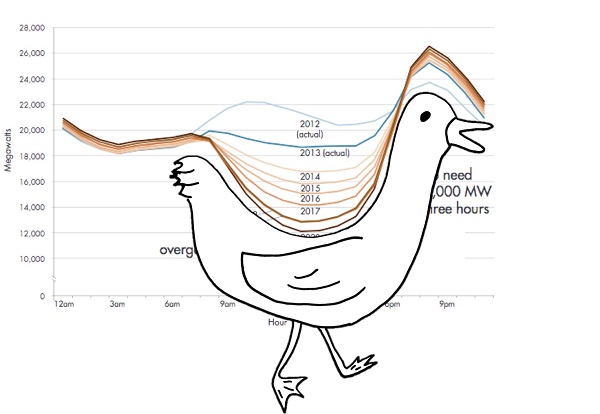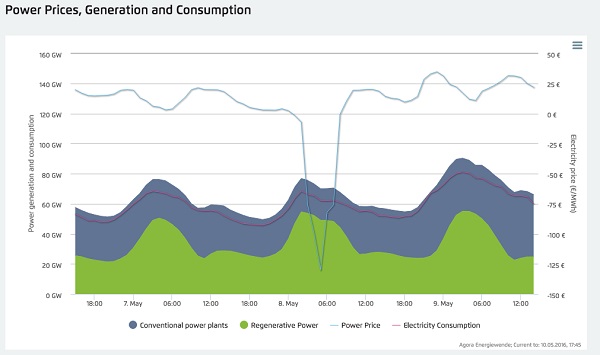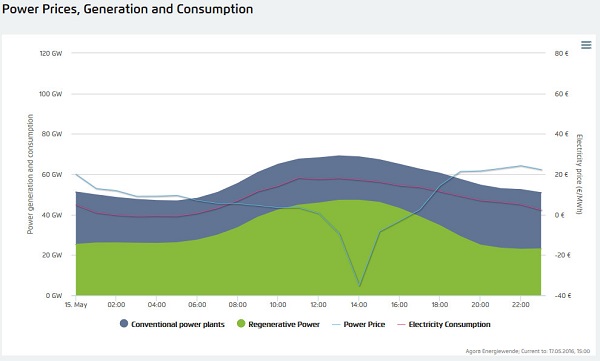Rapid technological innovation
Changes in technology are happening at a scale which was unimaginable before and will cause disruption in industry after industry.
Many leading companies won’t exist after the next decade as a result of rapid technological innovation and industry inter-connectivity.
Impacting commodity energy market
Over the last few years solar energy has become cheaper and cheaper. Cheap enough to start impacting some commodity energy markets today. Cheap enough that with continued progress it might alter the global outlook for energy supply within a decade.
Within a decade grid parity across many countries could be achieved. Grid parity means it’s cheaper to produce energy at home on the solar cells than to buy it from utilities.
Solar will reshape commodity power markets
Energy storage, when combined with solar power, could disrupt many utilities to the extent that customers move to an “off-grid” approach.
- In California power prices already have a mid-day low – the so called “duck curve.” It will soon be the norm in other high-sun demand centers, and the changing power price structure will shake utilities and industrial customers

The Duck Chart – Net load curves for March 31, from 2012 to 2020, based on analysis by California ISO. Source: California ISO.
- Looking further ahead, long-distance electric transmission can move solar power from good sites to demand centers and can reduce the impact of intermittency by averaging supply and demand across larger areas
- The capacity factors, global build rate and costs for wind power have been nearly flat for five years. Wind suddenly looks less interesting!
In markets where electricity prices are high, big-bang disruption is happening. Take Germany, farmers and private individuals own more than 50 percent of the solar output in the country, and the output is now significant enough that CEO Peter Terium of RWE – one of Europe’s top five electric and gas companies – noted last year that solar was having a profound impact on his business:
Our core markets are changing remarkably fast. With 32 gigawatts of solar – 40 percent of that on residential rooftops – consumers now interact with the market in ways that are unprecedented. Almost no other industry is currently undergoing such dynamic change as the energy sector ..… The success of this transformation of the energy industry will be decided at the local level.
Germany had so much renewable energy on Sunday 8th May 2016 that it had to pay people to use electricity. Power prices went negative for several hours as renewable supply hit nearly 90% of consumption.

And again on Saturday 15th May 2016 renewable energies hit 80% of consumption:

Graphics: www.agora-energiewende.de
Over the course of a full week between the 3rd of May 2016 and the 9th of May 2016, UK’s solar panels where generating more electricity from the sun than coal. It is thought to be the first time the UK has been without electricity from coal since the world’s first centralised public coal-fired generator opened at Holborn Viaduct in London, in 1882.
Australia is looking at similarly rapid and significant changes, and is expected soon to have the highest penetration of rooftop solar on the planet. Australian utilities also are dealing with similar dynamics, and looking to find new ways to remain relevant.
Every kilowatt that is now being produced by a third party or a consumer is a kilowatt not being sold by the utility. At the same time, utilities still carry the burden of building, maintaining and operating the bulk of the power delivery system.
Utility companies will be in serious trouble
If solar keeps advancing in the way it is, it will lead to serious trouble for utility companies.
The solar space alone is crowded with dozens of technologies and actors. Other companies focus on cost-effective storage, small wind, high efficiency on-site generators, electric vehicles and smart thermostats.
With the continued and rapid march of technology, it’s probably only a matter of time before the utility industry is ripe for disruption.
Short URL & Title:
Energy industry on the brink of disruption — https://www.torbenrick.eu/t/r/uey
Share it:
If you enjoyed this article, please take 5 seconds to share it on your social network. Thanks!








About The Author
Torben Rick
Experienced senior executive, both at a strategic and operational level, with strong track record in developing, driving and managing business improvement, development and change management. International experience from management positions in Denmark, Germany, Switzerland and United Kingdom